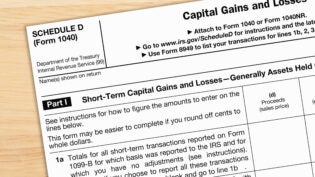Home > Finance > Tax and Accounting >
5 Tax Deductions Small Businesses Shouldn’t Fear Taking
By: 1800Accountant

Every tax-filing season, most Americans go on a quest to find as many tax deductions as possible. At the same time, many small business owners and independent contractors leave money on the table because they fear that certain tax deductions will draw the attention of auditors.
No one wants to get audited. But failing to take legitimate deductions can be costly. Here five tax deductions that small businesses owners should talk to their tax advisor about deducting.
1. Telephone Costs
The cost of the first telephone line in your home—digital, cellular, or hard-wired—is not deductible even if you primarily use that phone for your business. Business related long distance charges (if billed separately from the basic cost of the phone) are deductible.
A second phone number used specifically for a business is fully deductible.
A cellular phone used for business is deductible based on the percentage of its use devoted solely to business use. So if 30% of the email, text messages, and phone calls on a cell phone are business-related, then 30% of the data and monthly service fee would be deductible.
The key to successfully claiming this deduction is good records. You’ll need itemized bills in order to prove business use in the event of an audit.
2. Business Insurance
If you work out of your home, the cost of a standard homeowner’s hazard insurance policy is not tax deductible. Coverage for routine mishaps, fires, tornadoes, hurricanes, and other disasters offers peace of mind—but no tax deduction.
Insurance that is required specifically for your business, such as professional liability insurance (malpractice, errors & omissions, surety bonds, and so on) is usually tax deductible on state and federal tax returns. (A few states do not allow a deduction for state-mandated coverage, so check with your tax advisor.)
One significant deduction that small businesses shouldn’t overlook is the Small Business Health Care Tax Credit. If you pay at least 50% of the cost of health insurance for your employees (including yourself) as part of your benefits plan, then this credit can put money back into your pocket. For details, see the IRS website page devoted to the Health Care Tax Credit for details.
3. Auto & Travel Costs
Whether you are an employee, independent contractor, or business owner, the cost of your commute to and from work is not deductible (even if you work on the way). But if you are a business owner, employee, or self-employed individual who works at more than one place in a single day, the cost of getting from one workplace to the other is deductible.
The costs related to other local travel required for work—visits to clients (current and prospective), out-of-office business meetings, deliveries, supply and materials pick-up—are also deductible.
The IRS says that in order for local travel costs such as parking, mileage, and tolls for an automobile or public transit costs (train, bus, subway) to be deductible, it must be both an ordinary and necessary business expense. An ordinary expense is one that is common and accepted in your trade or business. A necessary expense is one that is helpful and appropriate for your trade or business.
As with other business deductions, good records, including a daily mileage log, are essential to prove the deduction in the event of an audit.
IRS Publication 463 covers the record-keeping requirements for travel, entertainment, gift, and car expenses. Your 1800Accountant.com tax advisor can also explain the requirements.
4. State and Local Taxes
One of the most often overlooked tax deductions for small businesses and self-employed people are the state and local taxes that are directly attributed to the trade or business.
For example, the annual fees for a state licenses (occupational licenses, occupation, liquor, chauffeur, building) and regulatory fees paid annually to state or local governments in connection with the business are deductible whether the feed are paid on behalf of an employee (including yourself) or whether they are charged to the business by the state.
Here are some examples of the kinds of taxes that are deductible—talk to your tax advisor for a complete list of taxes you may be able to use as a deduction or credit:
- Real estate tax imposed on business property. (Real estate taxes paid on a personal residence with a qualified home office are deducted as business-use-of-home expenses.)
- Any state or local tax on gross income (as distinguished from net income) directly attributable to a trade or business.
- Personal property taxes imposed on property used in a trade or business other than those for vehicles.
- Sales taxes imposed on sales of property or services at retail and measured by gross sales price or gross receipts. If this tax is collected from the buyer, the amount must be included in gross receipts. Note: Sales taxes paid on supplies or depreciable properties are added to the depreciation cost basis of the property.
- Compensating use taxes that are generally imposed on the use, storage, or consumption of an item brought in from another taxing jurisdiction.
- Federal highway use tax.
- Payroll taxes. There are limits on which employment taxes that a business must pay on behalf of employees, including: Social security tax of 6.2 percent on each employee’s wages up to $90,000; Medicare tax of 1.45 percent on each employee’s wages; Federal unemployment tax (FUTA) ranging from 0.8 percent up to 6.2 percent on each employee’s wages up to $7,000; and State unemployment tax, which varies by state.
One important caveat: independent contractors, sole proprietors, freelancers and self employed individuals cannot deduct Social Security taxes. Only an employer can deduct the portion of the social security tax it pays on behalf of an employee.
However, if you overpaid this tax, you can get a credit for Social Security over withholding. There is a limit on how much FICA taxes can be contributed each year. The tax is withheld on up to the Social Security earnings base, which is adjusted annually for inflation. For 2013 the base is $113,700.
If you become self-employed, or hold more than one job during the year, and your combined earnings exceeded the wage base, too much FICA may have been withheld, and you can claim the excess Social Security tax as a credit when you file your tax return.
5. Home Office Deduction
The IRS estimates that only about 3.4 million of the 14.6 million U.S. small business owners who have home offices deduct the cost.
In the past, the only way for someone who works at home to deduct most expenses was to keep detailed records. In 2013, a simpler way to qualify for the deduction is available to self-employed taxpayers and small businesses: a flat-rate home office deduction.
According to Gary Milkwick, CPA and Vice President at 1800Accountant.com, “The simplified method of computing the deduction will offer a chance to save money to anyone who may have qualified for the deduction in the past but have not taken it because they thought that the detailed record-keeping was too much of a hassle for the amount of benefit they could receive in the form of tax deductions.”
So instead of tracking utility bills, repair costs, and square footage all year, taxpayers can now deduct a flat rate of $5 per square foot for the portion of the home devoted to business use, with a maximum of $1,500. Milkwick explains, “The flat-rate deduction doesn’t cover the actual per-square foot cost of a home office for space and utilities. But depending on where the taxpayer lives, it can come a lot closer in some areas than other.”
According to Realtor.com, real estate in Brooklyn has an average per square foot cost of $374, while homes in Montgomery, Alabama, have an average per square foot cost of about $38.
“So the flat-rate deduction is a bigger benefit for those who live in low-cost areas of the country,” Milkwick says. “Even with certain limitations, the traditional method of calculating the home office deduction yields a significantly higher amount than $1,500. But that flat rate deduction might be more favorable to someone who has lower-cost housing elsewhere.”
Talk to a tax advisor to see if the new flat-rate deduction will benefit you, or whether you’d be better off tracking expenses the old way for a higher deduction.
This article was originally published by 1800 Accountant
Gary Milkwick is Vice President at 1800Accountant.com, a tax preparation and consulting firm based in New York City that serves thousands of small business owners. Gary previously worked with Fortune 500 clients at PricewaterhouseCoopers, and with a regional accounting firm in Atlanta, Georgia that provides tax and consulting services to small business owners.
Gary earned B.S. of Accounting and Master of Accountancy degrees from Brigham Young University and an MBA from UCLA’s Anderson School. He holds Series 7 and 66 securities licenses. He is a licensed CPA with the Personal Financial Specialist designation in New York and Georgia.
Published: July 31, 2013
4560 Views
4560 Views












